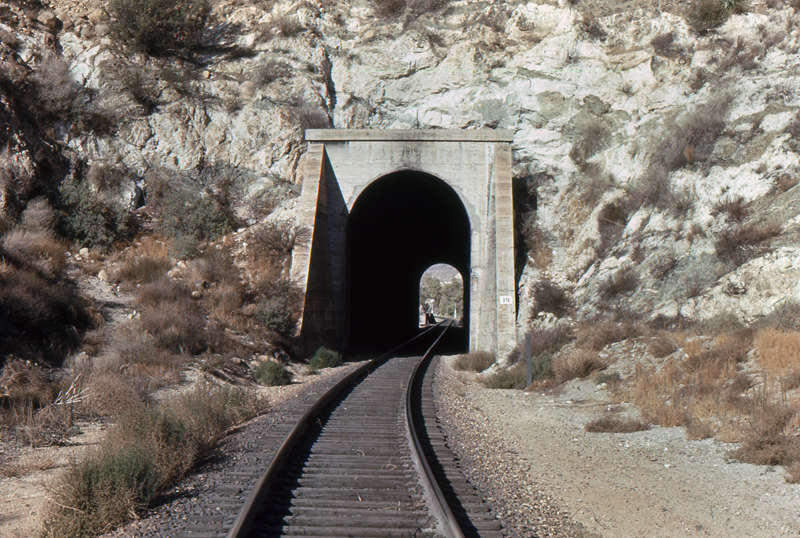|
|
39. Ribbons of Steel
Soon after the mighty San Fernando Tunnel was finished, Southern Pacific announced that on July 27, 1876, Tunnel Number 19 in Soledad Canyon had holed through at 223 feet. The work crews were now moving across the wide, smooth Santa Clara River plain at a rate of two and one-half to three miles per day.
At a furious pace some 1,500 Chinese hammered their way down the canyon, the ringing of sledges echoing off the dry walls of the arroyo as they slammed into iron spikes. A like number of laborers had already rounded the bend at Bouquet Junction and were headed for an historic meeting with their colleagues at John Lang's ranch.
Toward the end of August, Lang's hotel received a distinguished guest. The president of Southern Pacific, Charles Crocker, would personally oversee the final days of construction.
By September the northern and southern gangs were in sight of each other and on the evening of the fourth stood only 1,050 feet apart on the dusty, wind-blown roadway. The very air was charged with excitement. The Atlantic and Pacific Telegraph set up two tents to flash the news around the world at the exact moment the final spike was driven. Tomorrow would be Mr. Crocker's day at center stage. He would be more than equal to the occasion.
It was high noon on September 5, 1876. Engine Number 25, decked out with fruit branches, flowers and American flags, ground to a squealing halt a few feet west of Lang's hotel. On board were 335 prominent Angelenos including Mayor Prudent Baudry and ex-Governor John G. Downey. Also on hand was General Phineas Banning, the man who pioneered the stage and freighting business up San Francisquito Canyon twenty-two years earlier.
Crocker greeted them all warmly, then threw back his head in thunderous laughter when B.D. Wilson remarked that the land "was fit only for the production of horned toads and scorpions."
An hour later Engine Number 38 steamed into view, bringing a fifty-man contingent down from San Francisco. It too was draped with flags and carried Mayor Bryant, Leland Stanford and Collis Huntington. Almost immediately a brass band made the desolate hillsides resound with a lively tune. As the dignitaries exchanged greetings the crowd wildly cheered. Even the normally reserved Chinese shouted, caught up in the spirit of events.
The small army of Chinese, dressed in wide-brimmed basket hats, blue denim jackets and pants, with cotton sandals on their feet, lined up on either side of the unfinished roadbed. At a signal from Crocker they began laying iron with gusto. The band played and a rousing cheer went up when the two teams met and only one spike remained to be driven.
As the dust settled Crocker was handed a silver mallet and a golden spike fashioned by a Los Angeles jeweler of ore from the San Gabriel Mountains. The portly railroader concluded his brief remarks by saying, "Gentlemen, I am no public speaker, but I can drive a spike." He then proved it by hammering it home with six blows.
More music and cheers followed. Hats were thrown skyward and the locomotives shrieked in jubilation. California was, at last, bound together by twin ribbons of steel.
Shortly after 2 p.m. the great event was over and the engines were chugging back down the Soledad. The night brought a magnificent banquet at Union Hall in downtown Los Angeles for 190 male guests — none of whom, except for Crocker, had ever laid a rail or driven a spike.
The men who actually did the work celebrated in their own way, out there in the canyon with the horned toads and scorpions.
©1998 SANTA CLARITA VALLEY HISTORICAL SOCIETY • RIGHTS RESERVED.

The site owner makes no assertions as to ownership of any original copyrights to digitized images. However, these images are intended for Personal or Research use only. Any other kind of use, including but not limited to commercial or scholarly publication in any medium or format, public exhibition, or use online or in a web site, may be subject to additional restrictions including but not limited to the copyrights held by parties other than the site owner. USERS ARE SOLELY RESPONSIBLE for determining the existence of such rights and for obtaining any permissions and/or paying associated fees necessary for the proposed use.